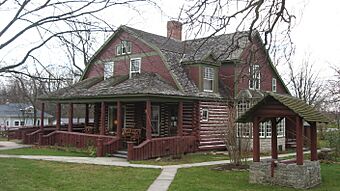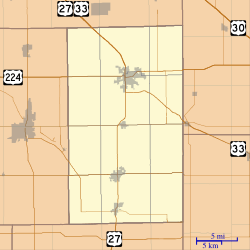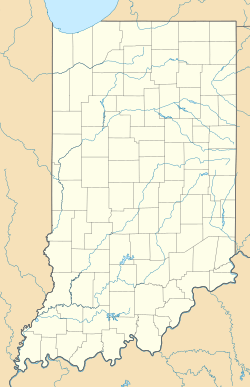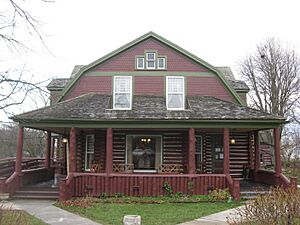Gene Stratton Porter Cabin (Geneva, Indiana) facts for kids
Quick facts for kids |
|
|
Gene Stratton Porter Cabin
|
|

Limberlost State Historic Site, November 2011
|
|
| Location | 200 E. 6th St., Geneva, Indiana |
|---|---|
| Area | 1.2 acres (0.49 ha) |
| Built | 1895 |
| NRHP reference No. | 74000027 |
| Added to NRHP | June 27, 1974 |
The Gene Stratton-Porter Cabin in Geneva, Indiana, is also known as the Limberlost Cabin or the Limberlost State Historic Site. This was the home of Gene Stratton-Porter, a famous Indiana author, from 1895 to 1913. It's a two-story log cabin with fourteen rooms. The cabin is located near the Limberlost Swamp on the edge of Geneva, Indiana. Gene Stratton-Porter designed this unique home, which is in the Queen Anne style, with help from an architect. The cabin was added to the National Register of Historic Places in 1974.
Stratton-Porter started her writing career in 1900. She used this cabin as her base for studying nature, collecting items, writing books, and taking photographs. While living here, she wrote The Song of the Cardinal (1903) and did research for Moths of the Limberlost (1912). The Limberlost area also inspired three of her novels: Freckles (1904), A Girl of the Limberlost (1909), and Laddie (1913).
Contents
History of the Limberlost Cabin
Gene Stratton-Porter, her husband Charles Dorwin Porter, and their daughter Jeannette moved to Geneva, Indiana, in 1887. They started building their new, two-story home in 1894. Stratton-Porter designed the house herself, with an architect's help. People at the time called it "the most impressive house in the Geneva area." The cabin was finished in 1895. This was the same year she began writing and publishing her first magazine articles.
The Porters named their new home Limberlost Cabin. This name came from its location near the Limberlost Swamp in Adams and Jay Counties. This swamp was where Stratton-Porter found ideas and inspiration for her stories. She lived in the cabin with her family for eighteen years. She often called their large, fourteen-room house simply "the cabin."
Changes to the Limberlost Swamp
Between 1888 and 1910, the wetlands of the Limberlost Swamp were drained. This was done to create more land for farming and other businesses. By 1912, the draining was complete. This destroyed the natural home for the wildlife that Stratton-Porter wrote about in her books. Because of these changes, Stratton-Porter decided to move.
In 1914, Stratton-Porter and her family moved from Limberlost Cabin. They went to a new cabin she called Wildflower Woods. This new home was near Sylvan Lake, close to Rome City, Indiana, about 80 miles (129 km) from Geneva. Charles Porter continued to live at Limberlost Cabin. He would travel to Sylvan Lake on weekends to be with his family. The Porters sold the Geneva property in 1923.
The Cabin as a Historic Site
The Limberlost Conservation Association of Geneva gave the Limberlost Cabin to the State of Indiana in 1947. Today, the Indiana State Museum and Historic Sites manages the cabin as a historic house museum. You can see some of Gene Stratton-Porter's belongings there. These include her collection of mounted moths, furniture, and other items. The property was added to the National Register of Historic Places in 1974. The site is open to the public. It includes the Limberlost Cabin, a carriage house, and a visitor center. You can take guided tours of the cabin.
What the Cabin Looks Like
Gene Stratton-Porter worked with an architect to design her family's two-story, fourteen-room home in the late 1890s. The idea for the house came from the Forestry Building at the World's Columbian Exposition in Chicago. The Porters had visited this fair in 1893.
The house is built in the Queen Anne style. It has an outside made of Wisconsin white cedar logs. The upper story has California redwood shingles. The front of the house has a porch that wraps around the front and east sides, supported by log pillars.
Inside, the fourteen-room home has wood-framed walls. The entrance hall, dining room, and library have red oak panels. On the first floor, there is also a kitchen, two bedrooms, a music room, a small conservatory (a room for plants), and a full bathroom. Stratton-Porter also used the bathroom as a darkroom for developing her photographs. The second floor has four large rooms. The home also featured seven fireplaces, big windows, and white oak floors. A barn and carriage house, also made of cedar logs, was built behind the home. The property also had a yard with fruit trees, vines, and bushes, plus a large flower garden.
Why the Cabin is Important
The Limberlost Cabin was more than just the Porters' home. It was where Stratton-Porter did her field research, collected natural history items, wrote her books, and took photographs. While living in Geneva, she spent a lot of time exploring, watching nature, sketching, and taking pictures in the Limberlost Swamp. This cabin is also where she started her writing career at age thirty-six.
Stratton-Porter used her fictional stories to teach readers about birds and nature. She also wove in romance and moral lessons. Her books were so popular during World War I that people said reprints of her novels were found "littered the trenches" where soldiers were fighting.
Her first published article appeared in Recreation magazine in 1900, when she lived at Limberlost Cabin. She also wrote her first novel, The Song of the Cardinal (1903), while living there. Stratton-Porter used the nearby swamp for research for her nature book, Moths of the Limberlost (1912). Also, the Limberlost area was the setting for three of her popular novels: Freckles (1904), A Girl of the Limberlost (1909), and Laddie (1913). While living in Geneva, Stratton-Porter became known as "The Bird Lady" and "The Lady of the Limberlost" to her friends and readers.





